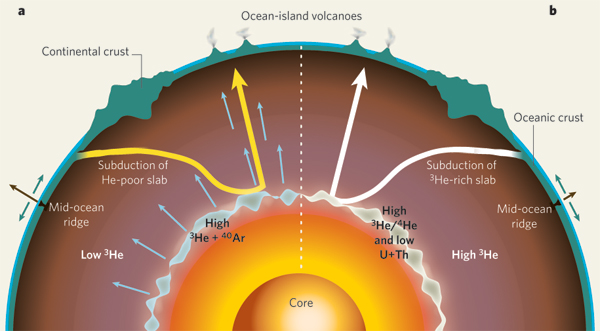
Jules Verne would have dug this plan: drill into the sea floor, through kilometres of the planet’s rocky crust to penetrate the denser underlying mantle. It is one of geology’s classic quests, conceived almost 60 years ago, at the peak of the plate-tectonics revolution. Since then, many have attempted it and failed. But an expedition starting this month is taking up the challenge once again.
In early December, the drill ship JOIDES Resolution will depart Colombo, Sri Lanka, and head for a spot in the southwestern Indian Ocean known as Atlantis Bank. There, it will lower a drill bit and try to screw it through 1.5 kilometres of rock, collecting a core sample as it goes. If all goes well, future expeditions — not yet scheduled or funded — will return and finalize the push into the mantle (see ‘Deep understanding’).
Normally, the crust–mantle boundary is thought to be marked by a feature known as the Mohorovičić discontinuity, or ‘Moho’, at which seismic waves change velocity. But at Atlantis Bank, the mantle is thought to bubble up as far as 2.5 kilometres above the Moho, making it easier to reach.
Reaching these deep-Earth frontiers “is one of the great scientific endeavours of the century”, says Henry Dick, a geophysicist at the Woods Hole Oceanographic Institution in Massachusetts and co-leader of the expedition.
Beneath continents, the Moho lies 30–60 kilometres down. But beneath oceans it is close enough to be reached with ship-borne drilling equipment. In the drilling campaign — dubbed the Slow Spreading Ridge Moho, or ‘SloMo’ Project — Dick hopes to reach the crust–mantle transition at Atlantis Bank, then one day return with a state-of-the-art Japanese vessel to reach the Moho itself at a depth of 5 kilometres or more. Along the way, scientists aim to answer profound questions about the planet, such as how molten rock rises from the interior and cools to form fresh ocean crust, a surface that blankets three-fifths of Earth.
Long-held dream
 A hole that deep “would be the window into things we have never seen before”, says Benoît Ildefonse, a geologist at the University of Montpellier in France.
A hole that deep “would be the window into things we have never seen before”, says Benoît Ildefonse, a geologist at the University of Montpellier in France.
Scientists first tried to reach the Moho in the middle of the twentieth century. In the 1960s, US scientists led ‘Project Mohole’, which drilled into the sea floor off Guadalupe Island, Mexico. The project reached a depth of just 183 metres before costs ballooned and Congress killed it. Still, Project Mohole gave birth to a series of scientific ocean-drilling programmes that have extracted cores from hundreds of locations around the world. These have revolutionized Earth science by retrieving sedimentary records that date back millions of years, offering clues to how continents pull apart and finding microbial life deep beneath the sea floor.
“We live on this Earth and we ought to know something about what happens beneath us,” says Walter Munk, an oceanographer at the Scripps Institution of Oceanography in La Jolla, California, who conceived Project Mohole with colleagues over cocktails one evening in 1957. He is gratified by the success of scientific ocean drilling overall, but would still like to see the mantle breached.
Expeditions have come close before. Between 2002 and 2011, four holes at a site in the eastern Pacific managed to reach fine-grained, brittle rock that geologists believe to be cooled magma sitting just above the Moho. But the drill could not punch through those tenacious layers. And in 2013, drillers at the nearby Hess Deep found themselves similarly limited by tough deep-crustal rocks (K. M. Gillis et al. Nature 505, 204–207; 2014).
Dick and his colleagues are targeting the Indian Ocean ridge rather than the eastern Pacific because much smaller quantities of lava feed the sea floor there, so there is less hard rock to drill through. At Atlantis Bank, tectonic forces have lifted the sea floor to just 700 metres beneath the waves.
Dick knows that it is possible to reach his preliminary goal of 1.5 kilometres, because he has done it before. In 1997, he led an expedition to Atlantis Bank that got that deep before disaster struck: the pipe snapped off in high winds, corkscrewed down inside the hole and plugged it up. “We’re going to make sure that doesn’t happen this time,” he says.
Along the way, researchers hope to explore not just geology, but biology, too. Geological mapping suggests that seawater may have percolated several kilometres deep at Atlantis Bank, triggering chemical reactions that turn the rock into a type known as serpentinite. These reactions generate methane, a gas that sub-sea-floor microbes often munch for energy. JOIDES Resolution scientists will be checking the rock cores for microorganisms, says Virginia Edgcomb, a microbiologist at Woods Hole who will be on the cruise.
SloMo’s first phase runs until 30 January. If the drilling goes well, Dick hopes to return with the JOIDES Resolution to reach 3 kilometres. And after that, he and his colleagues hope to use the Japanese drill ship Chikyu in the project’s third phase to drill all the way to the Moho. Launched a decade ago, Chikyu was meant to drill to the Moho in the western Pacific, but technical challenges and a lack of funding means that has not happened yet. With a capacity to drill as deep as 6 kilometres, Chikyu could finally allow geologists to realize their almost 60-year old dream.
Note: The above post is reprinted from materials provided by Nature. The original article was written by Alexandra Witze.










